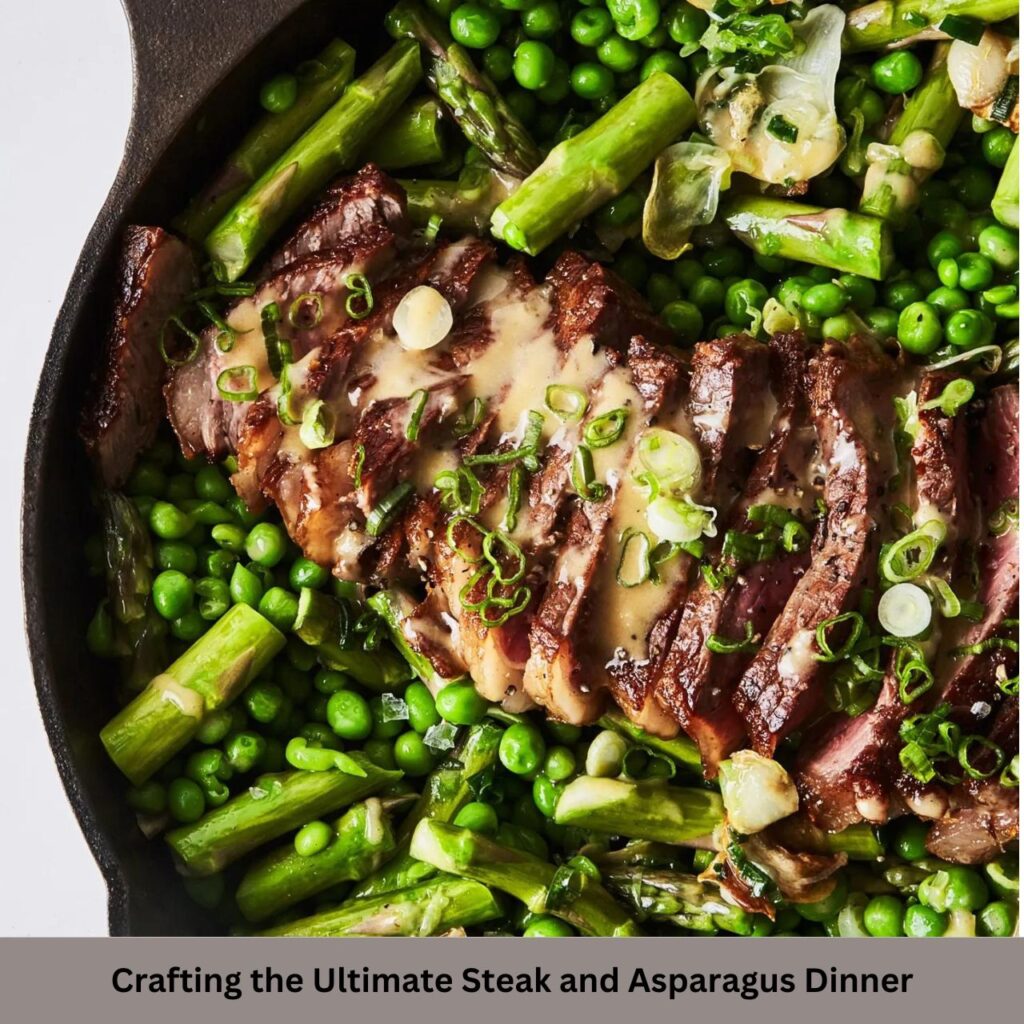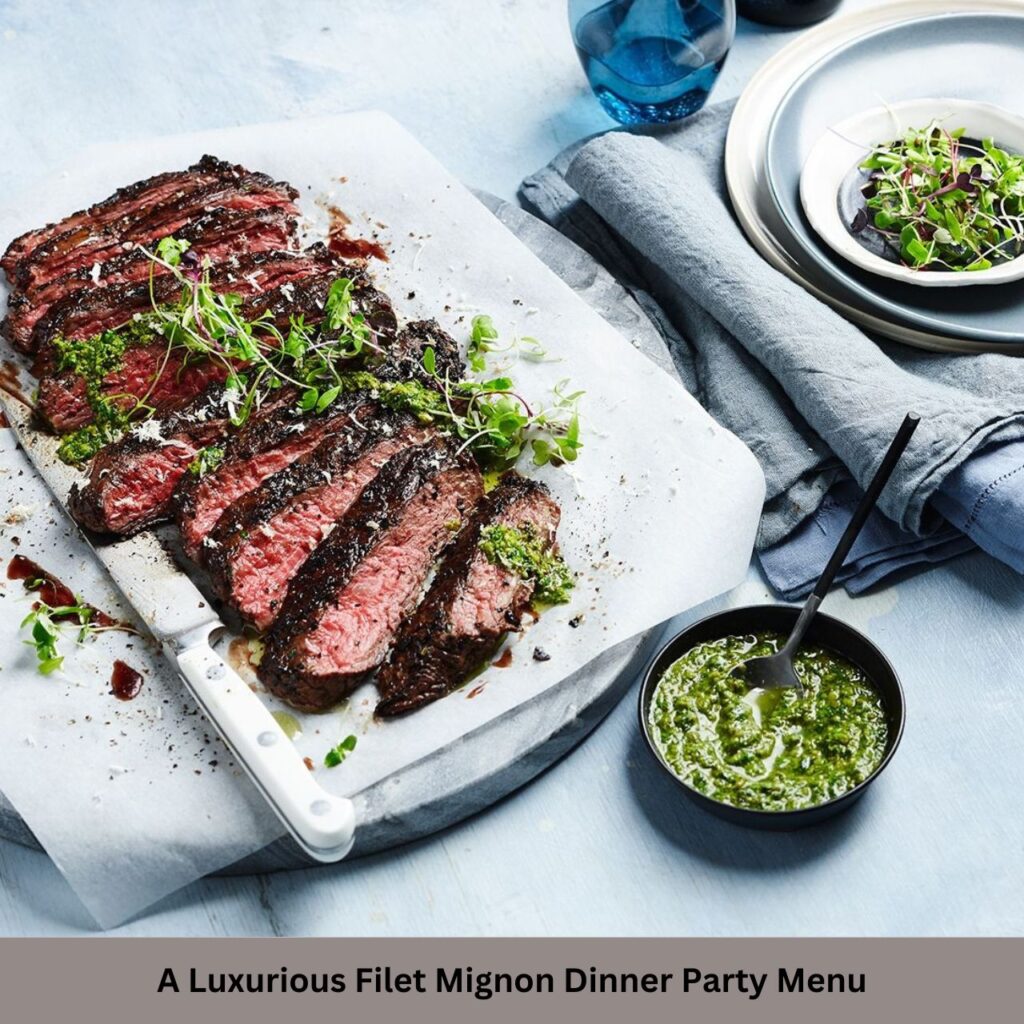Few meals can rival the comfort and satisfaction offered by a hearty bowl of beef noodles. Whether you’re battling a cold day or simply craving something robust and filling, this dish wraps you in warmth. The beauty of beef noodles lies in their versatility; it’s a dish that can be tailored to suit a wide range of tastes and occasions. While simple at its core, the combination of tender beef, chewy noodles, and a flavorful broth makes it an ideal meal that’s both nourishing and comforting.
It’s the kind of dish you can make on a weeknight or for a special family gathering. With its balanced mix of textures and flavors, beef noodles can be the star of your dining table. Perfect for casual meals or more formal settings alike. This recipe allows you to enjoy a restaurant-quality meal in the comfort of your home, with minimal effort and maximum satisfaction.
Why Beef Noodles Are A Crowd Favorite?
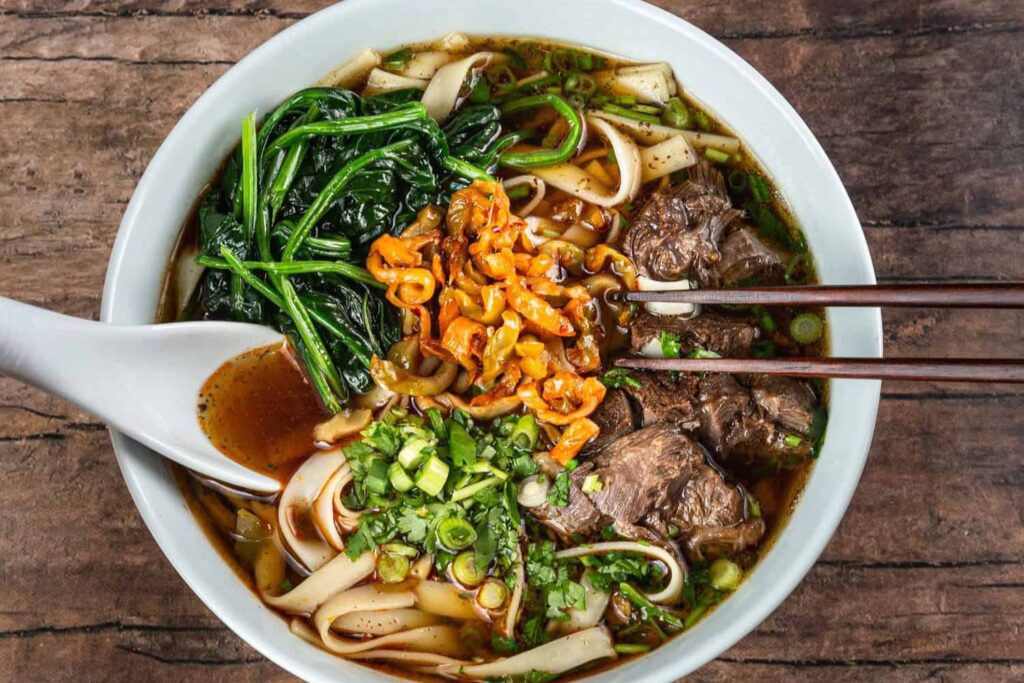
Beef noodles have long been a favorite across cultures due to their satisfying combination of protein-rich beef and comforting carbs. The appeal comes from the dish’s ability to marry simple ingredients into something greater than the sum of its parts. For many, it evokes a sense of nostalgia—perhaps reminding them of homemade meals or special family gatherings.
There’s something universally appealing about the heartiness of beef paired with the slurpable joy of noodles. Not only does it fill you up, but it also pleases the palate with rich, umami flavors. The tenderness of the beef contrasts perfectly with the smooth. Chewy texture of the noodles, making every bite a little adventure. And, for those who love a customizable meal, beef noodles allow for endless variations. From the choice of noodles to the type of broth and seasonings. It’s this adaptability that makes it a consistent crowd-pleaser, regardless of personal preferences or dietary needs.
A Brief History of Noodle Dishes Around the World
Noodles have a long and storied history, with roots tracing back to various cultures around the world. One of the oldest references to noodles is found in China, where records show noodle-like foods being eaten as far back as 4,000 years ago. Noodles were also a staple in many other regions, including Italy, and Japan. And the Middle East, evolving into distinct forms and flavors in each locale.
In Italy, for example, noodles became synonymous with pasta, taking on a variety of shapes and sauces. In Japan, soba and ramen gained prominence, offering a range of textures and flavors that vary by region. Middle Eastern cultures have their versions, with noodles often featured in brothy dishes or alongside fragrant spices. What’s fascinating about noodles is how they’ve become a universal food, yet each culture has its unique twist. The case of beef noodles, it’s a prime example of how a dish can take on different characteristics depending on where you’re eating it. From the spices used in the broth to the cut of meat and type of noodle chosen.
What Makes This Beef Noodles Recipe Stand Out?
The beauty of this beef noodles recipe lies in its balance of simplicity and depth. While many noodle dishes can be complex or require a long list of hard-to-find ingredients. This recipe keeps things accessible without sacrificing flavor. The focus is on building layers of taste, starting with a rich, slow-cooked broth that serves as the foundation for the dish. The beef is carefully selected to ensure tenderness. And it’s cooked in a way that maximizes its flavor without becoming tough.
Noodles, often an afterthought in some recipes, are given equal attention here. Cooked to just the right texture, they absorb the broth’s flavors while maintaining their satisfying bite. This recipe also allows for customization, whether you want to add heat with some chili oil or a hint of sweetness with a dash of hoisin. What makes this recipe truly stand out is its ability to be both simple and indulgent—perfect for a quick meal or a more elaborate feast.
Ingredients You’ll Need For The Perfect Beef Noodles
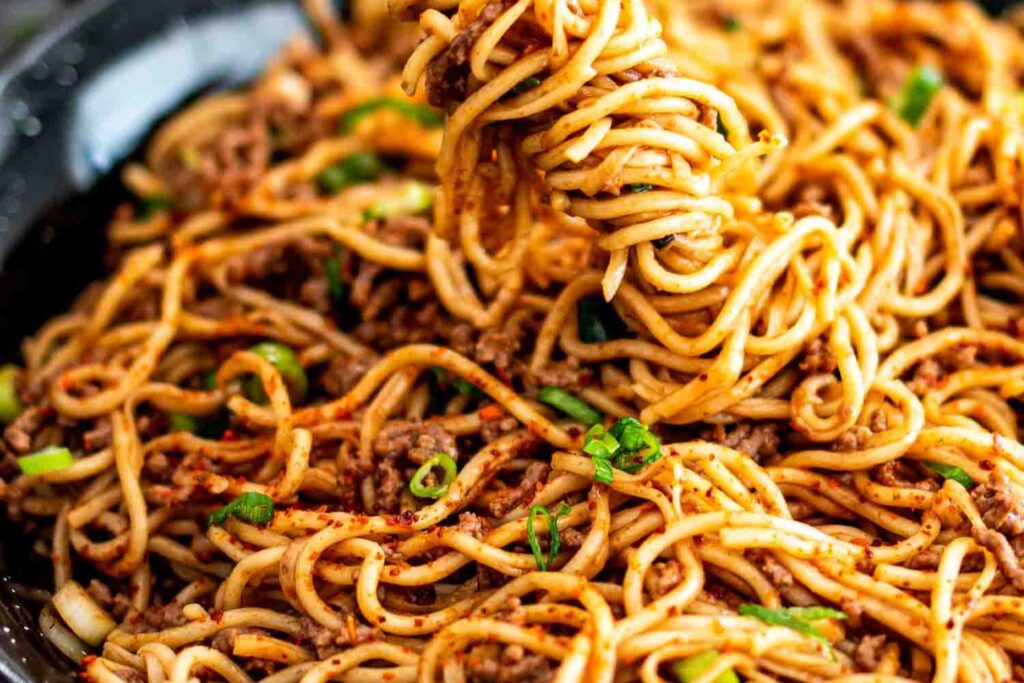
To create the perfect beef noodles, you’ll need a carefully curated list of ingredients that work in harmony. Start with high-quality beef—whether it’s chuck roast, sirloin, or brisket—depending on your preferred texture and flavor. For the broth, you’ll need beef stock or bone broth, soy sauce for umami, and garlic and ginger for warmth and complexity. A splash of sesame oil adds richness, while green onions and cilantro bring freshness.
Don’t forget the noodles: whether you opt for wheat noodles or rice noodles. Or even egg noodles, the type you choose will affect the overall texture of the dish. Vegetables like bok choy, mushrooms, or spinach can be added to round out the meal and provide a contrast of texture. Finally, season with salt, pepper, and optional chili flakes to taste. Each ingredient plays a role in elevating the dish, making it a well-rounded, flavorful meal that hits all the right notes.
Choosing the Best Cut of Beef for Your Noodles
Selecting the right cut of beef is crucial for achieving tender, flavorful bites that complement the noodles. Some cuts are better suited for slow cooking, while others shine in quicker preparations. For this dish, cuts like brisket, chuck, or short ribs are ideal if you’re looking to create a rich, succulent meal. These cuts become meltingly tender after slow simmering and infuse the broth with deep flavor. If you prefer something leaner or have less time, sirloin or flank steak can be sliced thinly and quickly seared to maintain a tender texture.
The key to selecting the best cut lies in understanding how you want the beef to interact with the other components. Heavily marbled cuts will render into the broth, enriching it with fat and depth. While leaner cuts will provide cleaner flavors and quicker cooking times. Your choice of beef should align with the overall experience you’re aiming to create in the final dish.
Understanding the Different Types of Noodles
Noodles may seem like a simple component, but the type you choose can significantly alter the texture and overall feel of the dish. In this recipe, wheat noodles are a popular choice due to their ability to hold up well in broth without becoming mushy. Egg noodles bring a richer, more robust flavor, thanks to their yolk content. And they tend to have a slightly firmer bite. Rice noodles, on the other hand, offer a lighter, more delicate option. Perfect if you’re looking to balance the richness of the beef.
For a more traditional Asian twist, you can opt for udon noodles, which are thick and chewy, or soba noodles, made from buckwheat, which provide a subtle earthiness. Each type of noodle offers its own unique texture and flavor profile, so choosing the right one is essential to creating a harmonious dish. Whether you prefer the bounce of wheat noodles or the silkiness of rice noodles, the choice ultimately enhances the overall experience of the meal.
How to Cook Beef For Tender, Juicy Flavor?
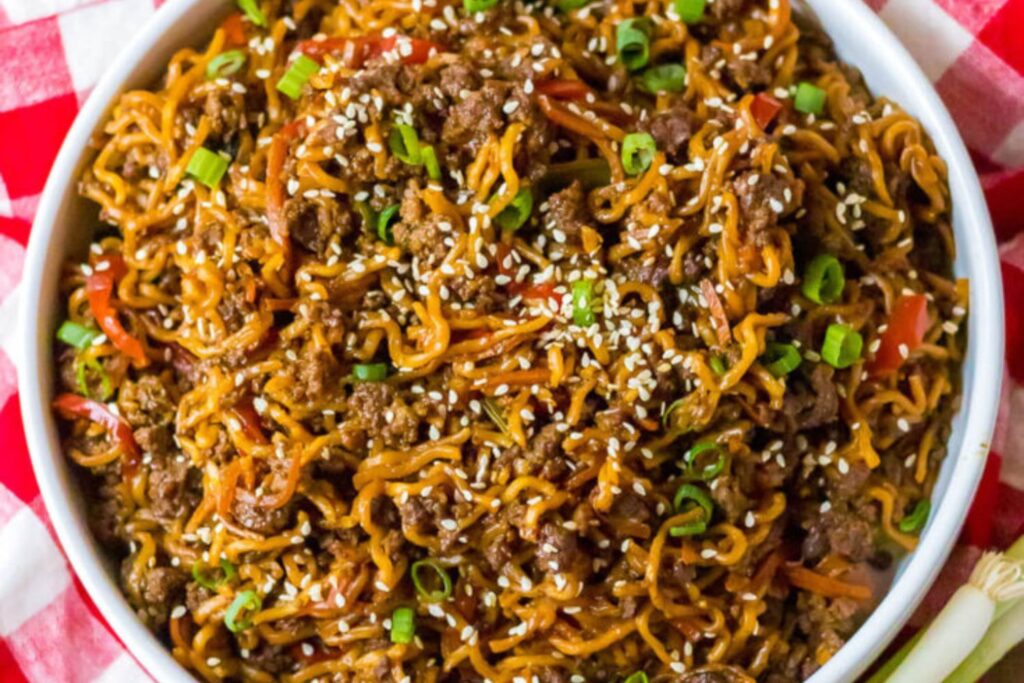
Cooking beef for noodles requires a careful balance of tenderness and flavor retention. One of the most effective methods is to sear the beef before simmering it in broth. This locks in juices and creates a caramelized crust that adds depth to the dish. If you’re using a tougher cut, such as chuck or brisket, low and slow cooking is your best approach.
Simmering the beef gently allows the connective tissues to break down, yielding a succulent, melt-in-your-mouth texture. For quicker-cooking cuts like flank or sirloin, slicing the beef thinly and flash-cooking it on high heat will result in tender slices that still maintain their integrity in the broth. Timing is everything—overcooked beef can become tough and chewy while undercooking it can leave it too rare for the dish’s intended texture. Aim for a balance where the beef is tender enough to complement the noodles but still holds its shape.
The Secret to a Rich and Flavorful Broth
The broth is the soul of any noodle dish, and in beef noodles, it serves as the backbone that ties the entire recipe together. The secret to a rich, flavorful broth lies in allowing it to develop over time. Using beef bones or marrow gives the broth a depth of flavor that’s hard to replicate with stock cubes or pre-made broths. Start by roasting the bones to bring out their natural sweetness, then simmer them gently with aromatics like ginger, garlic, and onions.
Soy sauce adds an umami punch, while star anise or cinnamon can be used to lend a hint of warmth and complexity. Skimming off impurities as the broth simmers ensures clarity and purity of flavor. If you’re pressed for time, you can still create a satisfying broth by using high-quality store-bought beef stock. Though slow-simmering homemade broth creates unmatched layers of taste.
Vegetables that Complement Your Beef Noodles
Adding vegetables to your beef noodles not only enhances its nutritional value but also introduces layers of texture and flavor that round out the dish. Bok choy is a classic addition, offering a crisp yet tender bite that contrasts beautifully with the rich beef. Mushrooms, especially shiitake or cremini, bring an earthy umami that complements the beef’s savory flavor.
Spinach or kale can be wilted into the broth for a pop of color and subtle bitterness, balancing out the richness of the meat. Carrots, thinly sliced, add a touch of sweetness, while bean sprouts provide crunch and freshness. If you prefer heartier vegetables, daikon radish or zucchini can absorb the broth’s flavors while maintaining their structure. The key to choosing the right vegetables is finding ones that harmonize with, rather than overpower, the other ingredients. Opt for vegetables that retain their texture when cooked. Ensuring that every bite is a symphony of tender beef, chewy noodles, and crisp greens.
How To Enhance The Flavor With Simple Seasonings?
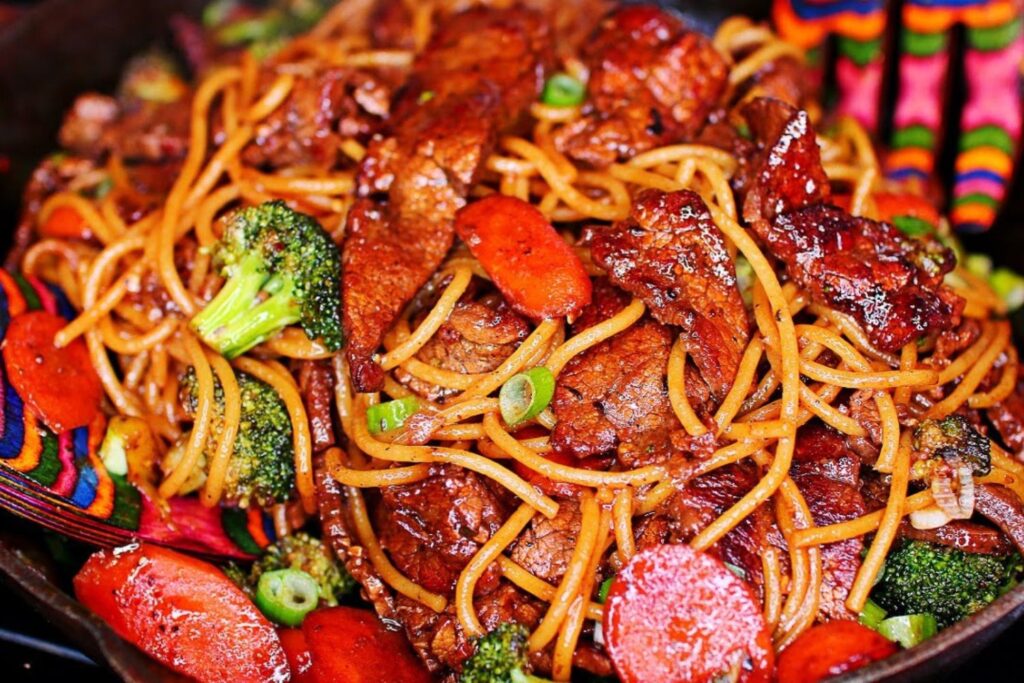
Sometimes, it’s the simplest seasonings that can elevate a dish from good to exceptional. In this beef noodles recipe, key seasonings like soy sauce, sesame oil, and ginger do most of the heavy lifting but don’t overlook the power of finishing touches. A dash of fish sauce can introduce a briny depth, while a pinch of sugar balances out the savory elements with a subtle sweetness.
Black or white pepper adds a touch of heat, enhancing the warmth of the broth without overwhelming it. For those who enjoy spicier food, a drizzle of chili oil or a sprinkle of red pepper flakes can add just the right amount of kick. Fresh herbs, such as cilantro or Thai basil, offer a burst of brightness at the end, cutting through the richness of the broth. These simple, everyday seasonings combine to create layers of flavor that make each spoonful more satisfying than the last.
Tips for Cooking Noodles to the Perfect Texture
Achieving the perfect noodle texture is an art in itself. Overcooked noodles can become mushy, turning the dish into a gloopy mess, while undercooked ones can be too firm, detracting from the overall experience. The key is to cook the noodles just shy of al dente, allowing them to finish cooking in the broth. This ensures that they absorb the rich flavors of the soup without losing their integrity. Another crucial tip is to always cook your noodles separately from the broth, then add them in just before serving. This prevents the noodles from soaking up too much liquid and becoming soggy. Rinse the noodles briefly under cold water after cooking to stop the cooking process and remove excess starch. By following these simple steps, you’ll end up with noodles that are perfectly tender, slightly chewy, and full of flavor.
How to Create the Perfect Balance of Meat, Noodles, and Vegetables?
A great beef noodle dish is all about balance. You want each bite to offer a harmonious mix of flavors and textures. Start by ensuring that the beef, noodles, and vegetables are evenly proportioned. Too much beef can overwhelm the dish, while too many noodles can make it feel carb-heavy. One effective strategy is to use the broth as a medium to tie everything together. The broth should be flavorful enough to elevate the beef and noodles but not so overpowering that it masks the subtlety of the vegetables. Layering the ingredients in your bowl is another way to maintain balance. Begin with the noodles, followed by the vegetables, then the beef, and finally ladle the broth over the top. This ensures that each bite offers a little of everything—tender beef, chewy noodles, and crisp, fresh vegetables.
The Importance Of Fresh Ingredients In This Recipe
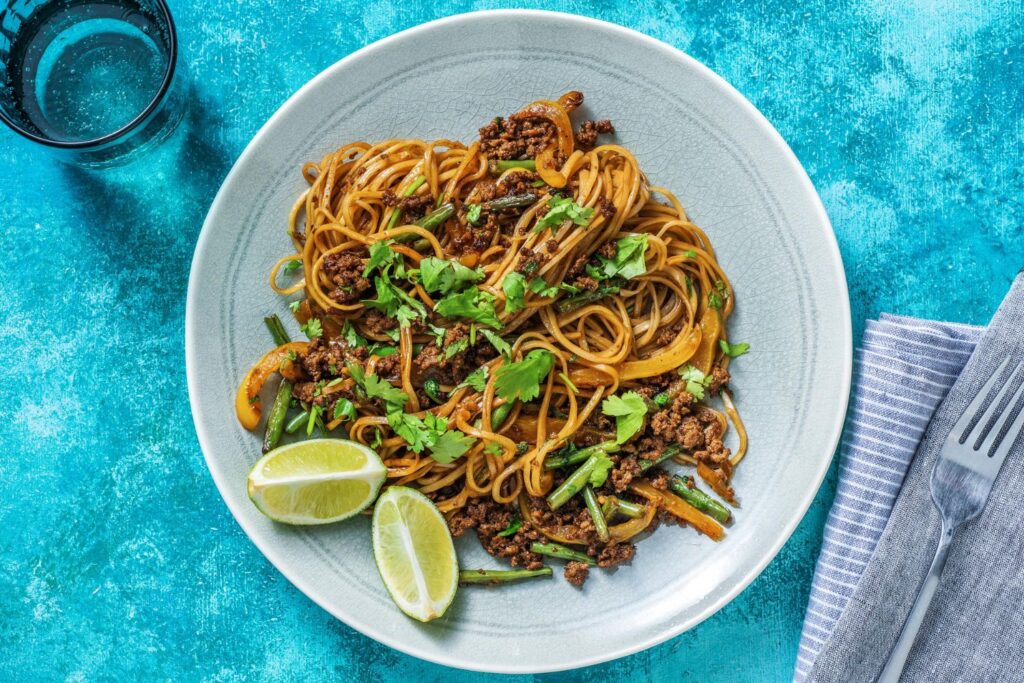
The quality of your ingredients will make or break your beef noodle dish. Fresh ingredients not only enhance the flavor but also elevate the dish’s nutritional value. Freshly cut beef, ideally sourced from a local butcher or a trusted grocery store, will have a more robust flavor and tender texture than pre-packaged or frozen cuts. Fresh vegetables provide a satisfying crunch and vibrant color, bringing balance and brightness to the dish. Aromatics like garlic, ginger, and green onions are at their most potent when fresh, infusing the broth with a lively. Fragrant depth that can’t be replicated with dried substitutes. Even the noodles themselves, if freshly made or purchased from a reputable supplier, contribute to the overall texture and mouthfeel of the dish. The importance of using fresh ingredients cannot be overstated—they turn a simple recipe into a truly unforgettable meal.
How to Add a Kick with Spices and Sauces?
For those who crave a bit more excitement on their palate. Adding a kick of spice can turn a comforting beef noodle dish into something truly bold. Chili oil is a classic choice, offering a slow-building heat that doesn’t overwhelm but enhances the complexity of the broth. Sriracha or a homemade chili-garlic sauce can also be drizzled on top for a sharper, more immediate burst of heat. If you’re a fan of spice, consider adding fresh sliced chilies or even Sichuan peppercorns, which bring a numbing. Tingling sensation that pairs beautifully with the richness of the beef. For those who prefer a milder dish, a splash of hoisin sauce can provide a sweet-savory contrast without the heat. The key is to find the right balance—too much spice can overpower the other flavors. While too little might leave the dish feeling flat. Start small and adjust according to your preference.
Cooking Techniques to Ensure a Hearty, Satisfying Dish
The cooking techniques you employ can significantly impact the outcome of your beef noodles. One of the most important steps is browning the beef before simmering it in the broth. This not only locks in the juices but also creates a rich. Caramelized flavor that adds depth to the overall dish. If you’re using a tougher cut of beef, slow-cooking it over low heat will break down the connective tissues, making the meat tender and succulent. For vegetables, a quick blanch in boiling water ensures they remain crisp and vibrant while still absorbing the flavors of the broth. Noodles should always be cooked separately and added to the broth at the last minute to prevent them from becoming soggy. By using these simple yet effective techniques, you’ll be able to create a dish that’s both hearty and satisfying, with layers of texture and flavor in every bite.
Why Simplicity Is Key In This Beef Noodles Recipe?
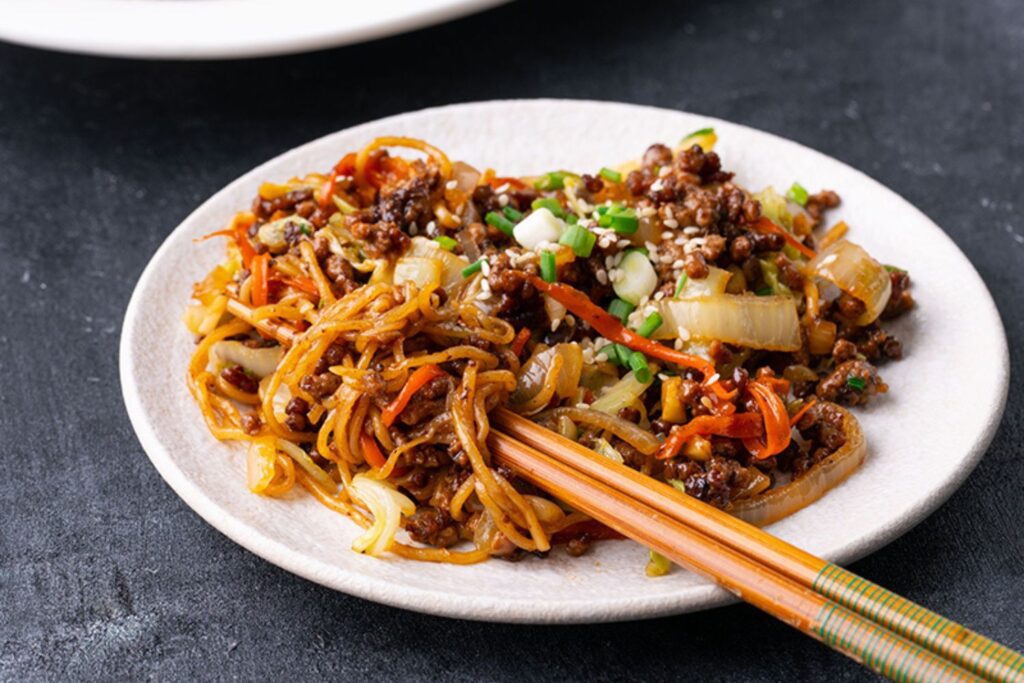
There’s a certain elegance in simplicity, and this beef noodles recipe embodies that philosophy. With just a handful of high-quality ingredients, you can create a dish that feels indulgent without being overly complicated. Often, the most delicious meals are the ones that focus on letting each component shine. Here, the beef is cooked to perfection, the broth is rich but not overly seasoned, and the noodles provide the perfect textural contrast. By keeping the recipe straightforward, you also give yourself room to experiment. Want to add some heat? Go for it. Prefer a sweeter broth? A touch of sugar can do wonders. The beauty of simplicity is that it serves as a canvas upon which you can build your flavor profile. This approach not only makes the recipe more accessible but also ensures that it remains versatile enough to suit any occasion.
How to Serve Your Beef Noodles for Maximum Enjoyment?
Presentation is often an overlooked aspect of home cooking. But how you serve your beef noodles can greatly enhance the overall experience. Start by using deep bowls that can hold plenty of broth without spilling over. Arrange the noodles at the bottom, followed by the beef and vegetables, making sure each component is visible and distinct. Pour the broth gently over the top, allowing it to flow naturally around the ingredients. Garnish with fresh herbs like cilantro or green onions, and add a slice of lime or a small dish of chili oil on the side for extra customization. By serving the dish thoughtfully, you’re not only appealing to the palate but also the eyes, elevating the meal from a simple dinner to a more enjoyable experience.
Pairing Your Beef Noodles with the Perfect Side Dish
While beef noodles are often a meal in themselves, pairing them with a complementary side dish can take the dining experience to the next level. A light, crisp salad, perhaps with a sesame-soy vinaigrette, can provide a refreshing contrast to the rich, hearty noodles. Steamed or pan-fried dumplings, filled with pork or vegetables, add a different texture. And flavor that complements the main dish without overwhelming it. If you’re in the mood for something a bit more indulgent, spring rolls with a tangy dipping sauce can be the perfect appetizer. Even something as simple as pickled vegetables can add a touch of acidity. Cutting through the richness of the beef and making the meal feel more balanced. The key is to choose a side that enhances, rather than competes with, the flavors of the beef noodles.
Creative Garnishing Ideas To Elevate Your Presentation
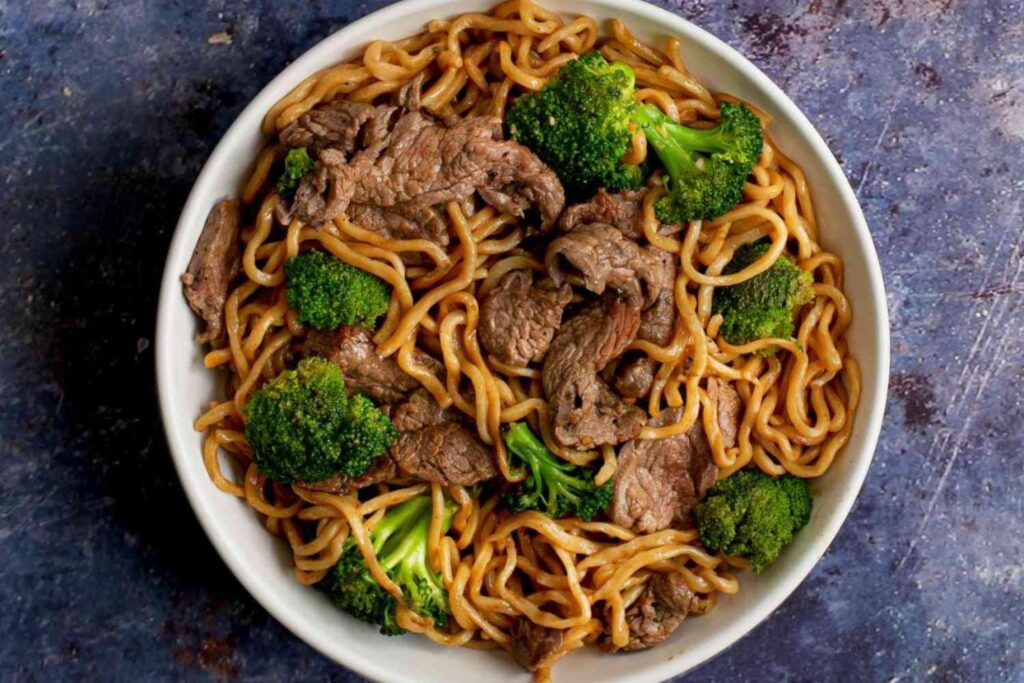
Garnishing is an art that can transform a bowl of beef noodles from everyday fare into something visually stunning. Fresh herbs like cilantro, Thai basil, or mint add a burst of color and fragrance that makes the dish more appetizing. A sprinkle of toasted sesame seeds or crushed peanuts provides a satisfying crunch, adding another layer of texture to the meal. Thinly sliced red chilies or a swirl of chili oil can introduce a pop of color and a hint of heat. While lime wedges on the side allow diners to customize the dish to their taste. For an extra touch of elegance, you can add a soft-boiled egg, halved and placed atop the noodles. The yolk, when broken, creates a rich, velvety texture that melds beautifully with the broth. These small, thoughtful additions not only enhance the presentation but also make the dining experience more interactive and enjoyable.
How to Store Leftover Beef Noodles Without Losing Flavor?
Storing leftovers from a dish as flavorful as beef noodles requires a little care to ensure that the flavors and textures remain intact. Start by separating the noodles from the broth, as leaving them together can cause the noodles to become mushy. Store the noodles in an airtight container, and keep the broth in a separate container to preserve its rich flavor. You can store the beef and vegetables together with the broth, as they will continue to absorb the flavors without losing their integrity. When reheating, warm the broth on the stove rather than in the microwave to maintain its depth of flavor. Add the noodles to the broth just before serving to ensure they don’t overcook. By following these simple steps, you’ll be able to enjoy your leftover beef noodles without compromising on taste or texture.
Reheating Tips to Keep Your Beef Noodles Delicious
When it comes to reheating beef noodles, the goal is to retain as much of the original flavor and texture as possible. The best way to do this is by reheating the broth and noodles separately. Warm the broth on the stovetop over low heat, allowing it to slowly come up to temperature without boiling. As this can cause the flavors to become too concentrated. If the broth has thickened, you can add a splash of water or stock to bring it back to its original consistency. Reheat the noodles by briefly dunking them in boiling water or microwaving them for 30 seconds, just enough to warm them through. Once everything is heated, combine the noodles, beef, and broth, and serve immediately. This method ensures that the noodles remain tender and the broth retains its complex, savory flavor.
Making Beef Noodles In Larger Quantities For Gatherings
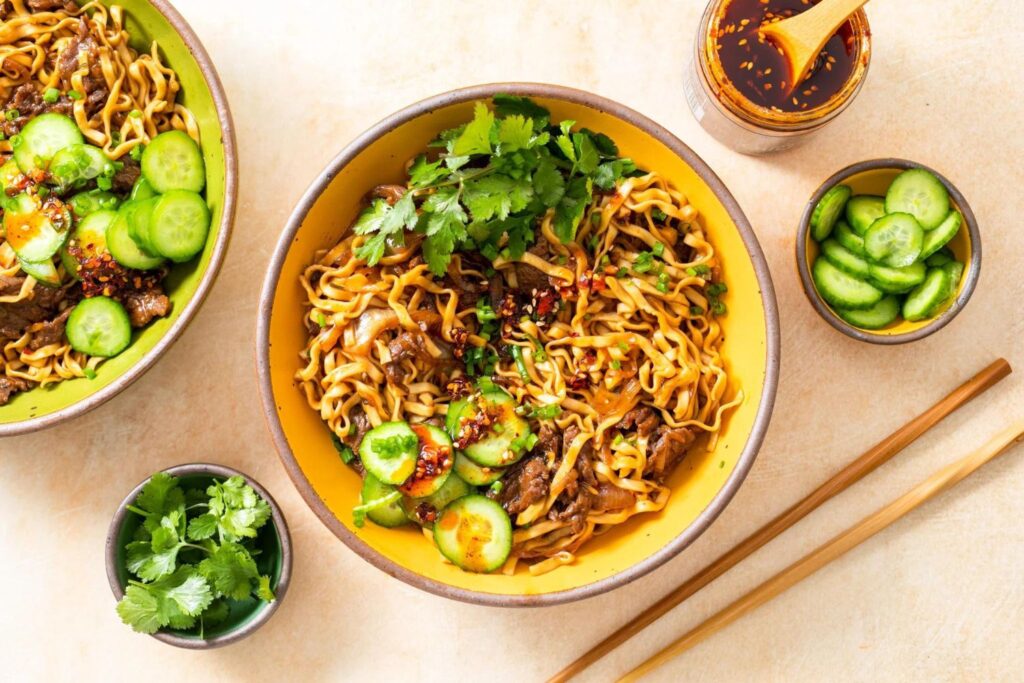
Beef noodles are an excellent dish to prepare in larger quantities for gatherings. As they are both filling and easy to scale up. The key to success when cooking for a crowd is preparation. Start by making the broth in advance; this allows the flavors to develop. And ensures that you won’t be rushed on the day of the event. You can also pre-cook the beef and slice it just before serving. If you’re worried about the noodles becoming too soft. Cook them in batches and add them to the broth as needed. Serve the noodles buffet-style, allowing guests to customize their bowls with their preferred vegetables, herbs, and seasonings. This interactive setup not only makes it easier for you as the host but also adds a fun, communal element to the meal.
Common Mistakes to Avoid When Making Beef Noodles
Even a seemingly simple dish like beef noodles can go awry if you’re not careful. One of the most common mistakes is overcooking the noodles, which can turn them mushy and unappetizing. Always cook the noodles separately from the broth and add them just before serving to avoid this issue. Another pitfall is not letting the broth simmer long enough. A rushed broth will lack depth and complexity, so give it time to develop. Overcrowding the bowl with too many ingredients can also disrupt the balance of the dish, making it too heavy. Finally, using low-quality beef or pre-packaged broth can result in a dish that tastes flat and uninspired. To avoid these mistakes, take your time, and use fresh, high-quality ingredients. And focus on creating a balance of flavors and textures.
How to Customize This Recipe for Different Taste Preferences?
One of the best things about beef noodles is how easily customizable the dish is to suit different tastes and dietary preferences. If you prefer a spicier dish, you can add chili oil, and fresh chilies. Or even a spoonful of Sichuan peppercorns to the broth. For those who like a sweeter profile, a drizzle of hoisin sauce or a spoonful of sugar can enhance the natural sweetness of the beef.
If you’re looking for a lighter version, swap out the beef for a leaner cut or even tofu. And use a clear broth instead of a rich, fatty one. Vegetarians can substitute the beef broth for a vegetable or mushroom broth. While still enjoying the hearty flavors that make this dish so satisfying. The beauty of this recipe is that it serves as a foundation—you can tweak it as you see fit to create a meal that’s perfect for your palate.
YouTube Video
Conclusion
In the end, beef noodles are the perfect example of how simple. Well-balanced dish can be both comforting and incredibly satisfying. Whether you’re cooking for yourself, your family, or a gathering of friends, this recipe delivers on all fronts. The tender beef, rich broth, and perfectly cooked noodles create a harmony of flavors. And textures that are sure to please any crowd. You can enjoy beef noodles for lunch, dinner, or even as a hearty snack due to its versatility and ease of preparation. You’ll keep coming back to this dish, thanks to its customizable nature and irresistible deliciousness.

